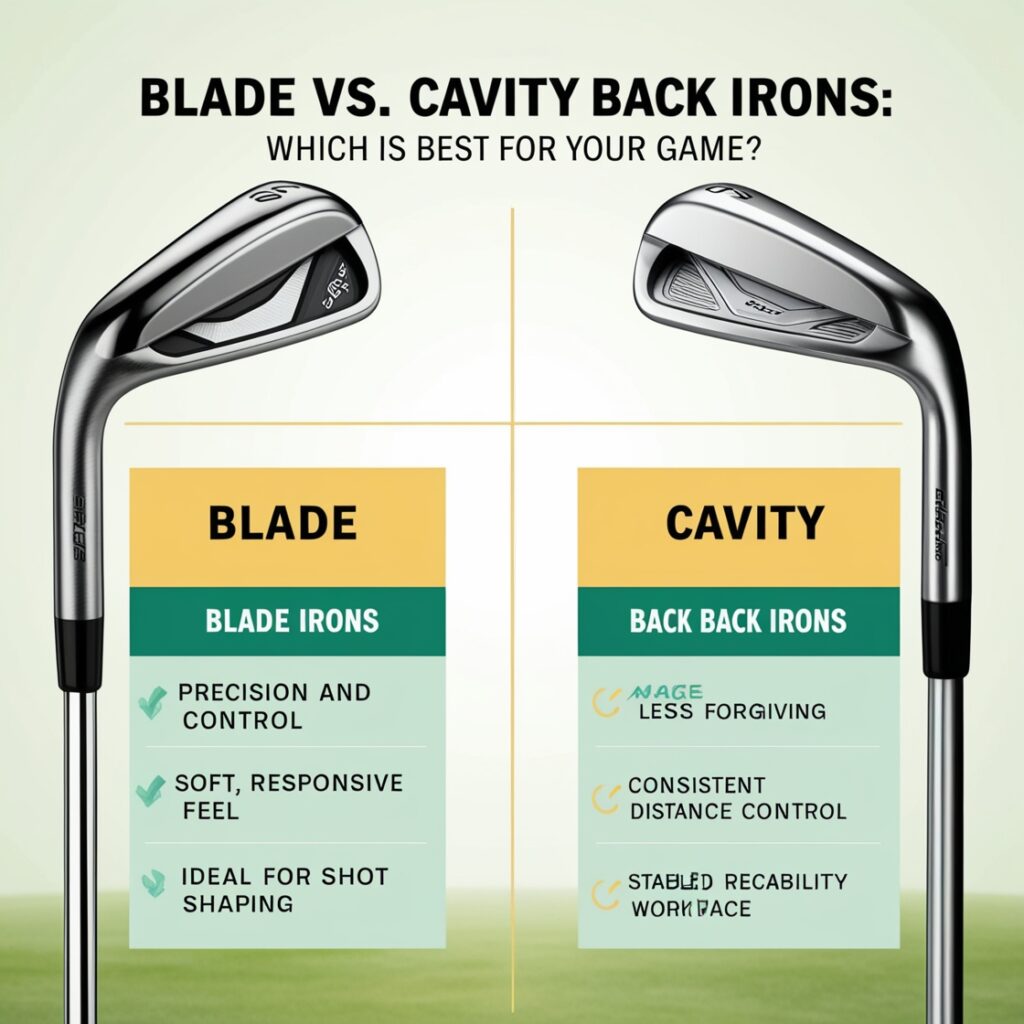Selecting the right set of irons can significantly impact your golf game. This guide will delve into the differences between blade vs. cavity back irons, helping you determine which is best for your needs. We’ll also suggest some top products in each category to aid your decision-making.

Key Features Comparison Table
| Feature | Blade Irons | Cavity Back Irons |
|---|---|---|
| Design | Thin top line and sole, traditional blade look | Hollowed-out back, larger club head, thicker top line and sole |
| Performance | Exceptional control and feedback | Easier to hit, more forgiving |
| Forged Irons | Often forged, providing a soft feel and better feedback | Can be forged or cast, generally more forgiving |
| Sweet Spot | Smaller sweet spot, requiring more precision | Larger sweet spot, increasing forgiveness |
| Ideal Users | Low handicap golfers seeking precision and control | High handicap players, beginners, or those needing game improvement |
| Feedback | Superior feedback and feel | Less feedback compared to blade irons |
| Control | Excellent for shaping shots and controlling trajectory | Less control over shot shape and trajectory |
| Forgiveness | Less forgiving on off-center hits | More forgiving, helps with consistency |
| Distance and Power | Requires precise striking for optimal distance | Increased distance and power, even on mishits |
Suggested Products
Blade Irons
Titleist 620 MB Irons

- Features: Muscle back design, forged from a single piece of carbon steel, thin top line and sole.
- Ideal For: Skilled golfers who prefer a traditional look and precise control over their shots.
Mizuno MP-20 MB Irons
- Features: Grain flow forged, copper underlay for enhanced feel, compact profile.
- Ideal For: Low handicap players seeking superior feel and feedback.
TaylorMade P7MB Irons

- Features: Compact grain forging, thin top line, minimal offset, muscle back design.
- Ideal For: Advanced players who value precision and shot-shaping capabilities.
Cavity Back Irons
Callaway Apex 21 Irons

- Features: Forged construction, AI-designed Flash Face, Tungsten Energy Core for forgiveness.
- Ideal For: Golfers looking for a blend of distance, forgiveness, and feel.
TaylorMade SIM2 Max Irons

- Features: Cap Back Design, Echo Damping System, Thru-Slot Speed Pocket.
- Ideal For: High handicap players and those seeking game improvement irons with maximum forgiveness.
Ping G425 Irons

- Features: Perimeter weighting, variable face thickness, Hydropearl finish for better turf interaction.
- Ideal For: Golfers needing consistent distance and forgiveness on every shot.
Read our full Ping G425 Irons Review
Detailed Comparison: Blade vs. Cavity Back Irons
Control and Precision
People know that blade irons are very precise and simple to handle. The smaller club head and sweet spot make it important to have a steady and accurate swing. This makes it simple for skilled players to shape shots and control their direction.
Cavity back irons, on the other hand, are better for players who need help with steadiness and distance because they are more forgiving. Cavity back irons are easier to hit and more accepting of off-center hits because they have a bigger sweet spot and weight around the edges.
Feedback and Feel
Blade irons stand out due to their superior feedback and feel. With its smaller sweet spot, Blade irons allow players to feel every subtle change in their swing, enabling them to make the necessary adjustments.
For players to improve their skills, they need this much feedback. On the other hand, cavity back iron construction reduces sensation. Golfers may not like the way this feels more like blade irons, but it can help newbies who need more flexibility.
Forgiveness and Consistency
The design facilitates the use of cavity back irons by enhancing their versatility. The bigger club head and hollowed-out back help spread the weight around the outside, which makes the sweet spot bigger and the irons easier to hit when they’re not in the center.
This part of the design helps players hit the ball more regularly, which is why cavity back irons are so popular with newbies and players with high handicaps. Because their sweet spot is smaller, blade irons require more accuracy and are less accepting of bad hits.
Distance and Power
Even if you hit the ball off-center, cavity back irons will help you hit it farther and with more power. With the outer balance and larger sweet spot, players can hit the ball farther with less effort. This can be especially helpful for players whose swings aren’t very fast.
Blade irons are very accurate and easy to control, but they might not hit the ball as far or with as much power as cavity back irons. To get the best reach with blade irons, players have to hit the ball very accurately.
Personal Experience and Insights
I have played golf for a long time, so I have had a lot of practice with both blade and cavity back irons. Based on my own experience, here are some things I’ve learned:
Blade Irons Experience
You need to be very skilled and accurate to play with blade irons. The smaller sweet spot requires more precision, but it gives you the best input and control.
I learned that blade irons allow me to shape my shots precisely and keep good control over their path. It’s very satisfying to hit a decent shot with a blade iron. I get instant input that helps me improve my swing. But when I wasn’t hitting regularly, the lack of forgiveness became clear, which made off-center hits less than ideal.
Cavity Back Irons Experience
When I switched to cavity back irons, the experience was different. They were much easier to hit, especially when you missed, because they had a bigger sweet spot and outer balancing. I saw a difference right away in accuracy and distance, even on hits that were off-center.
The extra flexibility helped me feel better about my swing, especially during practice and rounds where I wasn’t hitting the ball consistently. Even though cavity back irons didn’t give me as much input or control as blade irons, they were simple to use and forgiving, which made them a beneficial choice for days when my swing wasn’t working well.
FAQs
Q: Are blade irons suitable for high handicap golfers?
A: Blade irons don’t work well for high-handicap players because they have a smaller sweet spot and aren’t as flexible. People with a high score might do better with cavity back irons because they are more forgiving and easier to use.
Q: Can cavity back irons provide the same level of control as blade irons?
A: Although cavity back irons aim to be forgiving and enhance your ball striking distance, they typically offer less control and feedback compared to blade irons. Blade irons may be preferable for advanced players who care a lot about shaping their shots and controlling their direction because they provide more accurate feedback.
Q: Do blade irons go further than cavity back irons?
A: Blade irons and cavity back irons don’t always go farther. Cavity back irons are made to give you the most distance and grace, even if you hit the ball off-center. The distance a player can hit the ball with blade irons depends more on how skilled and accurate they are.
Q: What are super game improvement irons?
A: The super game got better. Irons aim to provide you with optimal space and grace. Most of the time, they have bigger club heads and more advanced features that make it easier for newbies and people with high handicaps to get better results with less work.
Q: How do I know if I should play blade irons or cavity back irons?
A: Which one you choose should depend on your skill level, how often you hit the ball, and your own personal tastes. Blade irons might be better for you if you are a skilled player who likes having control and getting feedback. Cavity back irons are probably better for you if you are a beginner or a high-scoring player who wants flexibility and ease of use.
Conclusion
Choosing between blade vs. cavity back irons depends on your skill level, swing consistency, and personal preferences. Blade irons offer precision, control, and superior feedback, making them ideal for experienced golfers who prioritize shot shaping and trajectory control. Cavity back irons, on the other hand, provide forgiveness, ease of use, and increased distance, making them perfect for beginners and high handicap players looking for super game improvement irons.
Understanding the strengths and weaknesses of each type of iron allows you to make an informed decision that enhances your performance and enjoyment on the golf course. Whether you play blade irons or cavity back irons, the key is to choose golf clubs that match your skill level and help you hit the ball more effectively. Remember, the right set of irons can make a significant difference in your game, so take the time to assess your needs and preferences before making a choice.
